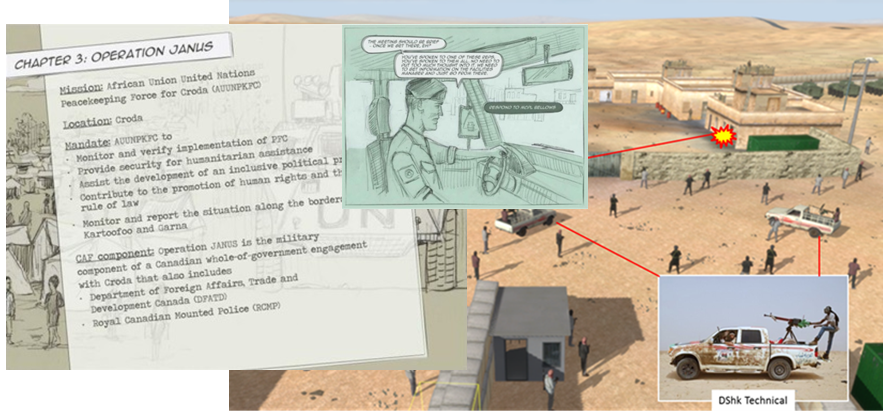Simulated scenarios, whether created as virtual first-person games or eLearning modules, provide an opportunity to create realistic environments without committing expensive “real-life resources”. For the purposes of our work, HSI® often constructs simulated scenarios for task analysis and training.
For example, HSI® developed scenarios for the Defence Research and Development Canada (DRDC) CORA C4ISR simulator to be used in experiments investigating the effectiveness of dismounted Blue Force Tracking and Identification Friend or Foe at the section level. Scenarios were documented in written format and incorporated virtual environments from Virtual Battlespace to illustrate event sequences. HSI® also produced evaluation instruments to assess teamwork performance and the realism of cognitive load in the simulated environment.
HSI® also assisted with the creation of multiple scenarios related to Soldiers Missions, Tasks and Lessons Learned, for the purpose of conducting task analyses. This work was in support of the Future Small Arms Research program’s Human Factors research led out of DRDC Toronto. The client required a critical task analysis for select players to investigate infantry target engagement tasks using current in-service and future small arms capabilities, including surveillance and target acquisition technology.
HSI®’s scenario-based approach has also applied to the design of an engaging eLearning module for the Canadian Armed Forces’ Civil Military Cooperation (CIMIC) Operators. Critical to their training, CIMIC Operators must learn important skills, such as communication, relationship building, and negotiation skills. HSI® constructed customized, operational scenarios immersing CIMIC Operators in a believable, coherent thematic story. The Operators interact with a number of actors within the scenario and make a series of decisions that depend on their communication, relationship building, and negotiation skills. Using a scenario-based approach, CIMIC Operators receive feedback through the consequences of their choices. Importantly, these consequences occur within the context of the story so that learners maintain their suspension of belief and stay immersed in the learning. At the end of the module, Operators receive an evaluation score, as well as suggestions for improvement.
Simulated scenario development enables HSI® to capture data like mental workload and situational awareness, identify future research questions, explore capability gaps, and increase the transfer of knowledge through interactive learning. Above are just two examples. We encourage you to ask us more about what scenario development can do for your project or organization.
Jeff Bennett





